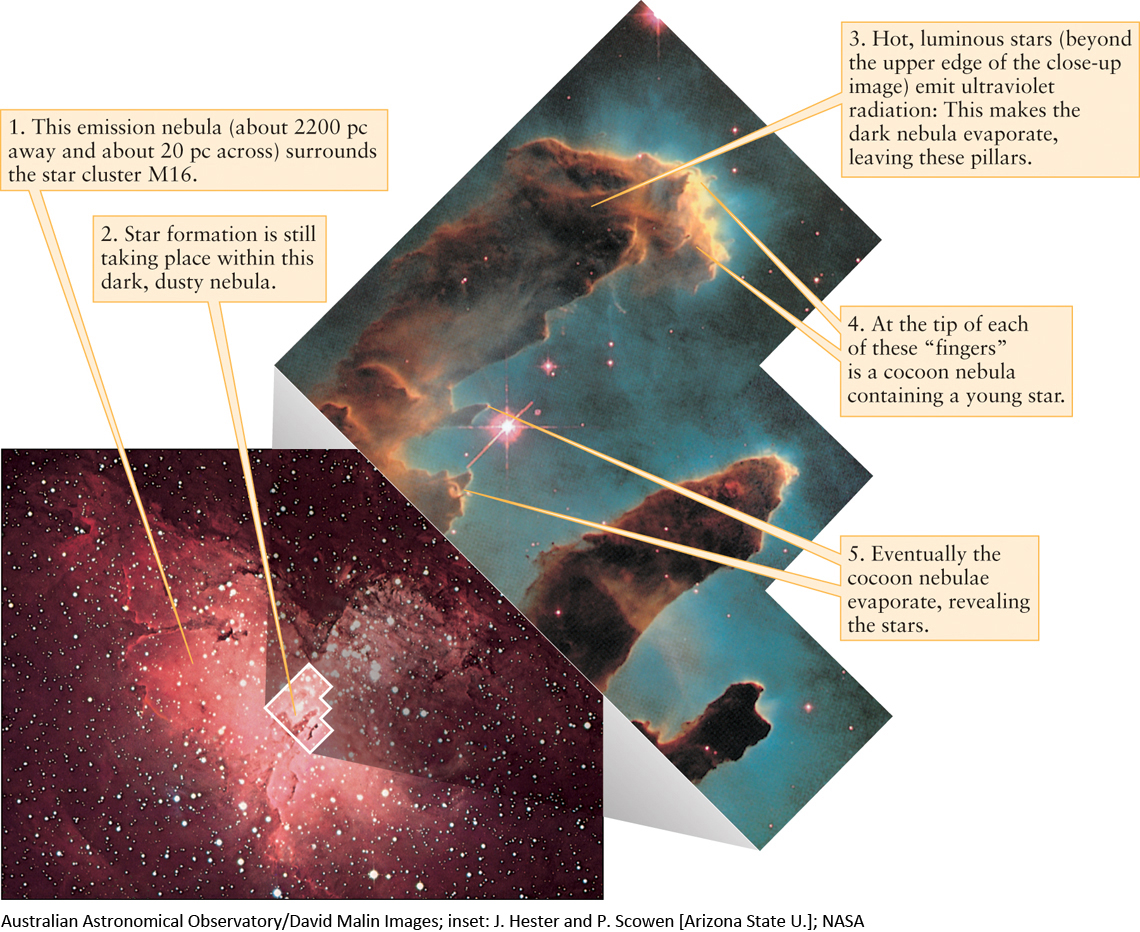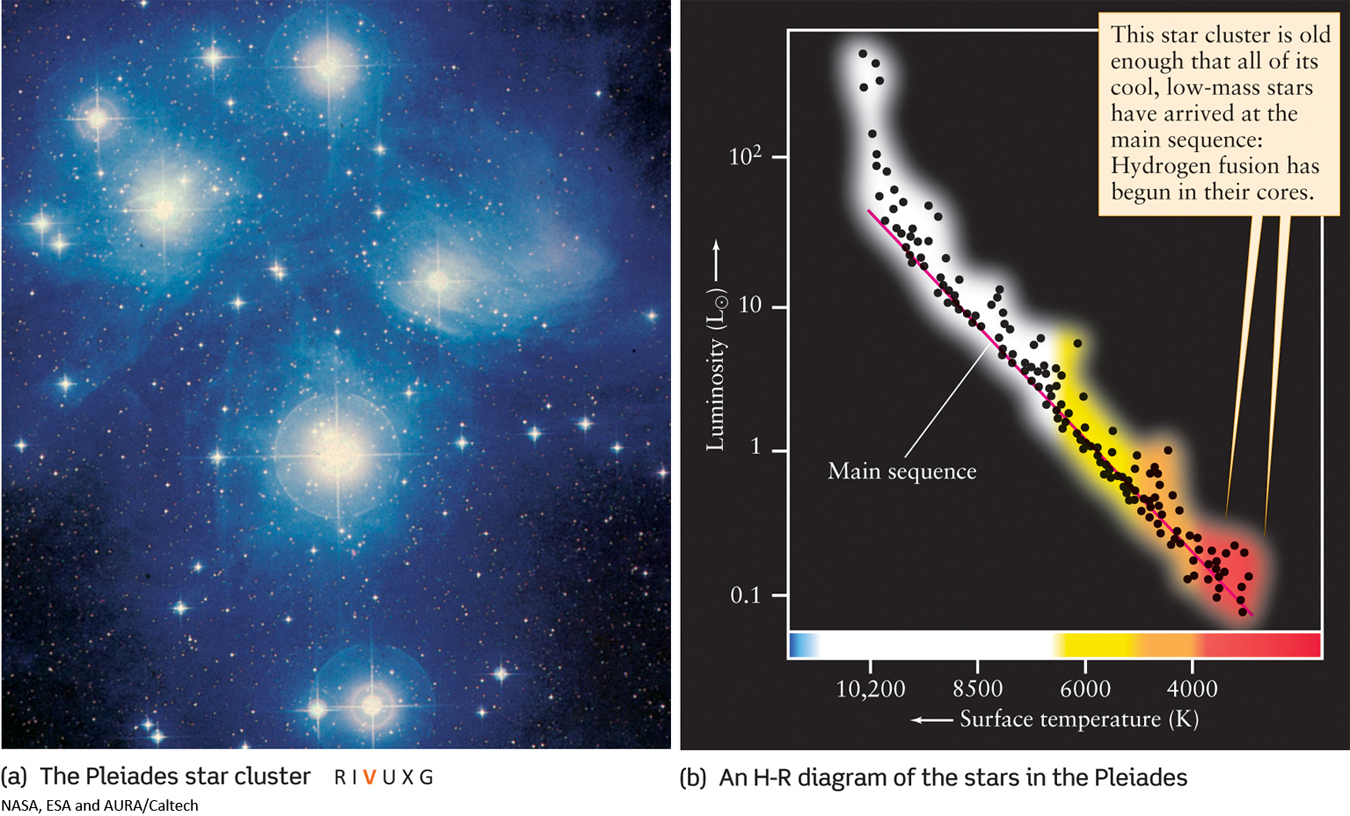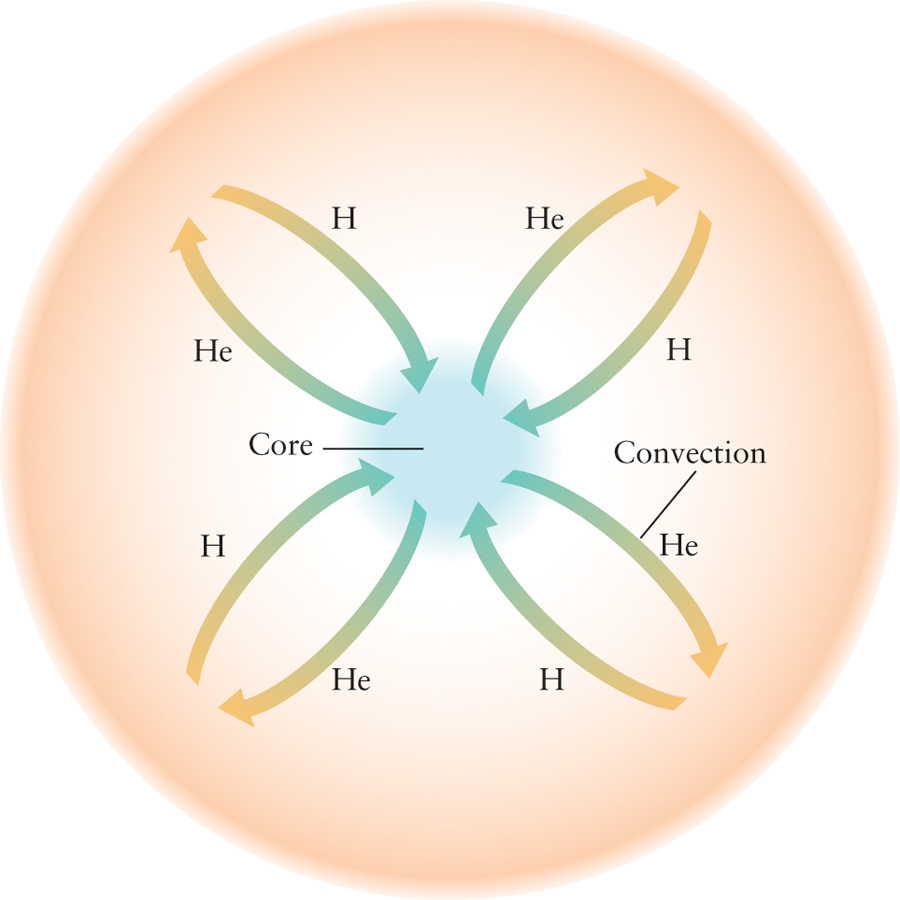11-2 Most stars shine throughout their lives by converting hydrogen into helium through nuclear fusion
When a protostar has evolved into a stable main-sequence star, regardless of mass, all stars are fundamentally similar. The fundamental energy source inside stars is the release of energy from the conversion of hydrogen into helium. When hydrogen atoms collide with each other at extremely high temperatures and pressures, they can combine to form larger helium atoms and release tremendous amounts of energy in the process. This process occurs in the very center of Sunlike stars.
The total time that a star will spend fusing hydrogen into helium in its core, and thus the total time that it will spend as a main-sequence star, is called its main-sequence lifetime. For our Sun, the main-sequence lifetime is about 12 billion (1.2 × 1010) years. Hydrogen fusion has been going on in the Sun’s core for the past 4.56 billion (4.56 × 109) years, so our Sun is less than halfway through its main-sequence lifetime.
Stars Form in Clusters
Dark nebulae contain tens or hundreds of solar masses of gas and dust, enough to form many stars. As a consequence, these nebulae tend to form groups or clusters of young stars. One such cluster is M16, shown in Figure 11-10.

259
In addition to being objects of great natural beauty, star clusters give us a unique way to compare the evolution of stars with differing masses, because clusters typically include stars with a range of different masses, all of which began to form out of the parent nebula at roughly the same time. Thus, they have roughly the same chronological age and similar initial chemical composition.
ANALOGY
A foot race is a useful way to compare the performance of sprinters because all the competitors start the race simultaneously. A young star cluster gives us the same kind of opportunity to compare the evolution of stars of different masses that all began to form roughly simultaneously. Unlike a foot race, however, the entire “race” of evolution in a single cluster happens too slowly for us to observe; as Figure 11-7 shows, protostars take many thousands or millions of years to evolve significantly. Instead, we must compare different star clusters at various stages in their evolution to piece together the history of star formation in a cluster.
All the stars in a cluster may begin to form nearly simultaneously, but they do not all become main-sequence stars at the same time. As you can see from their evolutionary tracks (see Figure 11-7), high-mass stars evolve more rapidly than low-mass stars. Consistently, the more massive the protostar, the sooner it develops the central pressures and temperatures needed for steady hydrogen fusion to begin. As we shall see, stars in the same cluster also do not age at the same rate nor do they leave the main sequence at the same time.
Figure 11-11a shows a young star cluster called the Pleiades. The photograph shows gas that must have initially surrounded this cluster but has since dissipated into interstellar space, leaving only traces of dusty material that forms nebulae around the cluster’s stars. This implies that that the Pleiades must be older than NGC 2264, the cluster shown in Figure 11-12a, which is still surrounded by a nebula. The H-R diagram for the Pleiades in Figure 11-11b bears out this idea. In contrast to the H-R diagram for NGC 2264 (Figure 11-12b), nearly all the stars in the Pleiades are on the main sequence. The cluster’s age is about 100 million years, which is how long it takes for the least massive stars to finally begin hydrogen fusion in their cores.


CAUTION
Note that the data points for the most massive stars in the Pleiades (at the upper left of the H-R diagram in Figure 11-11b) are above the main sequence. This is not because these stars have yet to arrive at the main sequence. Rather, these stars were the first members of the cluster to arrive at the main sequence some time ago and are now the first members to leave it. They have used up the hydrogen in their cores, so the steady process of core hydrogen fusion that characterizes main-sequence stars cannot continue. A loose collection of stars such as NGC 2264 or the Pleiades possesses barely enough mass to be held together by gravitation. Occasionally, a star moving faster than average will escape, or “evaporate,” from the cluster. Indeed, by the time the stars are a few billion years old, they may be so widely separated that a cluster no longer exists.
 Go to Video 11-3
Go to Video 11-3
What happens to a star like the Sun after the core hydrogen has been used up, so that it is no longer a main-sequence star? As we will see, it expands dramatically to become a red giant. To understand why this happens, it is useful to first look at how a star evolves during its main-sequence lifetime. The nature of that evolution depends on whether its mass is less than or greater than about 0.4 M⊙.
260
Question
ConceptCheck 11-4: Where does the increasing amount of helium come from inside the core of a star?
Main-Sequence Stars of 0.4 M⊙ or Greater: Consuming Core Hydrogen
A protostar becomes a main-sequence star when steady hydrogen fusion begins in its core and it achieves a stable balance between the inward force of gravity and the outward pressure produced by hydrogen fusion. From the point in time a star has stabilized its core hydrogen fusion, a star slowly, but predictably, undergoes noticeable changes in luminosity, surface temperature, and radius during its main-sequence lifetime. These changes are a result of hydrogen fusion in the core, which alters the chemical composition of the core. As an example, when our Sun first formed, its composition was the same at all points throughout its volume: by mass, about 74% hydrogen, 25% helium, and 1% heavy elements. But as Figure 11-13 shows, the Sun’s core now contains a greater mass of helium than of hydrogen. (There is still enough hydrogen in the Sun’s core for another 5.4 billion years as a main-sequence star.)

CAUTION
Although the outer layers of the Sun are also predominantly hydrogen, there are two reasons why this hydrogen cannot undergo fusion. The first reason is that while the temperature and pressure in the core are high enough for thermonuclear reactions to take place, the temperatures and pressure in the outer layers are not. The second reason is that there is no flow of material between the Sun’s core and outer layers, so the hydrogen in the outer layers cannot move into the hot, high-pressure core to undergo fusion. The same is true for main-sequence stars with masses of about 0.4 M⊙ or greater. (We will see below that the outer layers can undergo fusion in main-sequence stars with a mass less than about 0.4 M⊙.)
Thanks to hydrogen fusion in the core, the total number of atomic nuclei in a star’s core decreases with time: In each reaction, 4 hydrogen nuclei are converted to a single helium nucleus. With fewer particles bouncing around to provide the core’s internal pressure, the core contracts slightly under the weight of the star’s outer layers. Compression makes the core denser and increases its temperature. As a result of these changes in density and temperature, the pressure in the compressed core is actually higher than before.
As the star’s core shrinks, its outer layers expand and shine more brightly. Here’s why: As the core’s density and temperature increase, hydrogen nuclei in the core collide with one another more frequently, and the rate of hydrogen fusion in the core increases. Hence, the star’s luminosity increases. The radius of the star as a whole also increases slightly, because increased core pressure pushes outward on the star’s outer layers. The star’s surface temperature changes as well, because it is related to the luminosity and radius. As an example, theoretical calculations indicate that over the past 4.56 × 109 years, our Sun has become 40% more luminous, grown in radius by 6%, and increased in surface temperature by 300 K (Figure 11-14).

261
As a main-sequence star ages and evolves, the increase in energy outflow from its core also heats the material immediately surrounding the core. As a result, hydrogen fusion can begin outside the core in this surrounding material. By tapping this fresh supply of hydrogen, a star manages to eke out a few million more years of main-sequence existence.
Question
ConceptCheck 11-5: What happens to the size of a star if its core shrinks, increasing in temperature and density?
Main-Sequence Stars of Less Than 0.4 M⊙: Consuming All Their Hydrogen
The story is somewhat different for the smallest and least massive main-sequence stars, with masses between 0.08 M⊙ (the minimum mass necessary for sustained thermonuclear reactions to take place in a star’s core) and about 0.4 M⊙. These stars, of spectral class M, are called red dwarfs because they are small in size and have a red color due to their low surface temperature. They are also very numerous; about 85% of all stars in the Milky Way Galaxy are red dwarfs.
In a red dwarf, helium does not accumulate in the core to the same extent as in the core of a larger star, like our Sun. The reason is that in a red dwarf there are convection cells of rising and falling gas that extend throughout the star’s volume and penetrate into the core. These convection cells drag helium outward from the core and replace it with hydrogen from the outer layers (Figure 11-15). The fresh hydrogen can undergo thermonuclear fusion that releases energy and makes additional helium. This helium is then dragged out of the core by convection and replaced by even more hydrogen from the red dwarf’s outer layers.

262
As a consequence, over a red dwarf’s main-sequence lifetime essentially all of the star’s hydrogen can be consumed and converted to helium. The core temperature and pressure in a red dwarf is less than in the Sun, so thermonuclear reactions happen more slowly than in our Sun. Calculations indicate that it takes hundreds of billions of years for a red dwarf to convert all of its hydrogen to helium. The present age of the universe is only 13.7 billion years, so there has not yet been time for any red dwarfs to become pure helium.
Question
ConceptCheck 11-6: Why do convection cells in the smallest of main-sequence stars, red dwarfs, result in such long lifetimes when they have such small amounts of fuel?